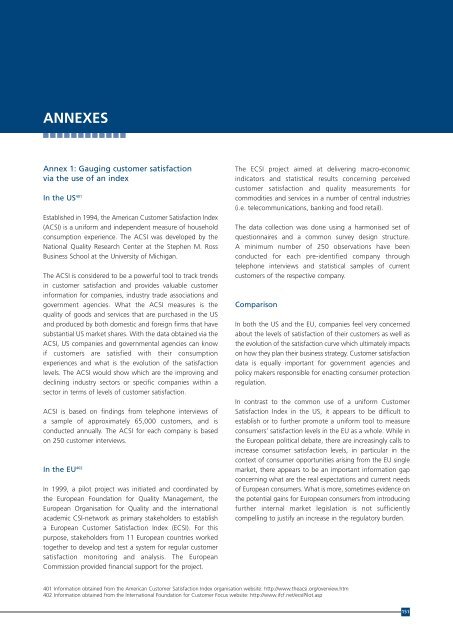A comparative analysis of the US and EU retail banking markets - Wsbi
A comparative analysis of the US and EU retail banking markets - Wsbi
A comparative analysis of the US and EU retail banking markets - Wsbi
You also want an ePaper? Increase the reach of your titles
YUMPU automatically turns print PDFs into web optimized ePapers that Google loves.
ANNEXES<br />
Annex 1: Gauging customer satisfaction<br />
via <strong>the</strong> use <strong>of</strong> an index<br />
In <strong>the</strong> <strong>US</strong> 401<br />
Established in 1994, <strong>the</strong> American Customer Satisfaction Index<br />
(ACSI) is a uniform <strong>and</strong> independent measure <strong>of</strong> household<br />
consumption experience. The ACSI was developed by <strong>the</strong><br />
National Quality Research Center at <strong>the</strong> Stephen M. Ross<br />
Business School at <strong>the</strong> University <strong>of</strong> Michigan.<br />
The ACSI is considered to be a powerful tool to track trends<br />
in customer satisfaction <strong>and</strong> provides valuable customer<br />
information for companies, industry trade associations <strong>and</strong><br />
government agencies. What <strong>the</strong> ACSI measures is <strong>the</strong><br />
quality <strong>of</strong> goods <strong>and</strong> services that are purchased in <strong>the</strong> <strong>US</strong><br />
<strong>and</strong> produced by both domestic <strong>and</strong> foreign firms that have<br />
substantial <strong>US</strong> market shares. With <strong>the</strong> data obtained via <strong>the</strong><br />
ACSI, <strong>US</strong> companies <strong>and</strong> governmental agencies can know<br />
if customers are satisfied with <strong>the</strong>ir consumption<br />
experiences <strong>and</strong> what is <strong>the</strong> evolution <strong>of</strong> <strong>the</strong> satisfaction<br />
levels. The ACSI would show which are <strong>the</strong> improving <strong>and</strong><br />
declining industry sectors or specific companies within a<br />
sector in terms <strong>of</strong> levels <strong>of</strong> customer satisfaction.<br />
ACSI is based on findings from telephone interviews <strong>of</strong><br />
a sample <strong>of</strong> approximately 65,000 customers, <strong>and</strong> is<br />
conducted annually. The ACSI for each company is based<br />
on 250 customer interviews.<br />
In <strong>the</strong> <strong>EU</strong> 402<br />
In 1999, a pilot project was initiated <strong>and</strong> coordinated by<br />
<strong>the</strong> European Foundation for Quality Management, <strong>the</strong><br />
European Organisation for Quality <strong>and</strong> <strong>the</strong> international<br />
academic CSI-network as primary stakeholders to establish<br />
a European Customer Satisfaction Index (ECSI). For this<br />
purpose, stakeholders from 11 European countries worked<br />
toge<strong>the</strong>r to develop <strong>and</strong> test a system for regular customer<br />
satisfaction monitoring <strong>and</strong> <strong>analysis</strong>. The European<br />
Commission provided financial support for <strong>the</strong> project.<br />
The ECSI project aimed at delivering macro-economic<br />
indicators <strong>and</strong> statistical results concerning perceived<br />
customer satisfaction <strong>and</strong> quality measurements for<br />
commodities <strong>and</strong> services in a number <strong>of</strong> central industries<br />
(i.e. telecommunications, <strong>banking</strong> <strong>and</strong> food <strong>retail</strong>).<br />
The data collection was done using a harmonised set <strong>of</strong><br />
questionnaires <strong>and</strong> a common survey design structure.<br />
A minimum number <strong>of</strong> 250 observations have been<br />
conducted for each pre-identified company through<br />
telephone interviews <strong>and</strong> statistical samples <strong>of</strong> current<br />
customers <strong>of</strong> <strong>the</strong> respective company.<br />
Comparison<br />
In both <strong>the</strong> <strong>US</strong> <strong>and</strong> <strong>the</strong> <strong>EU</strong>, companies feel very concerned<br />
about <strong>the</strong> levels <strong>of</strong> satisfaction <strong>of</strong> <strong>the</strong>ir customers as well as<br />
<strong>the</strong> evolution <strong>of</strong> <strong>the</strong> satisfaction curve which ultimately impacts<br />
on how <strong>the</strong>y plan <strong>the</strong>ir business strategy. Customer satisfaction<br />
data is equally important for government agencies <strong>and</strong><br />
policy makers responsible for enacting consumer protection<br />
regulation.<br />
In contrast to <strong>the</strong> common use <strong>of</strong> a uniform Customer<br />
Satisfaction Index in <strong>the</strong> <strong>US</strong>, it appears to be difficult to<br />
establish or to fur<strong>the</strong>r promote a uniform tool to measure<br />
consumers’ satisfaction levels in <strong>the</strong> <strong>EU</strong> as a whole. While in<br />
<strong>the</strong> European political debate, <strong>the</strong>re are increasingly calls to<br />
increase consumer satisfaction levels, in particular in <strong>the</strong><br />
context <strong>of</strong> consumer opportunities arising from <strong>the</strong> <strong>EU</strong> single<br />
market, <strong>the</strong>re appears to be an important information gap<br />
concerning what are <strong>the</strong> real expectations <strong>and</strong> current needs<br />
<strong>of</strong> European consumers. What is more, sometimes evidence on<br />
<strong>the</strong> potential gains for European consumers from introducing<br />
fur<strong>the</strong>r internal market legislation is not sufficiently<br />
compelling to justify an increase in <strong>the</strong> regulatory burden.<br />
401 Information obtained from <strong>the</strong> American Customer Satisfaction Index organisation website: http://www.<strong>the</strong>acsi.org/overview.htm<br />
402 Information obtained from <strong>the</strong> International Foundation for Customer Focus website: http://www.ifcf.net/ecsiPilot.asp<br />
151
















